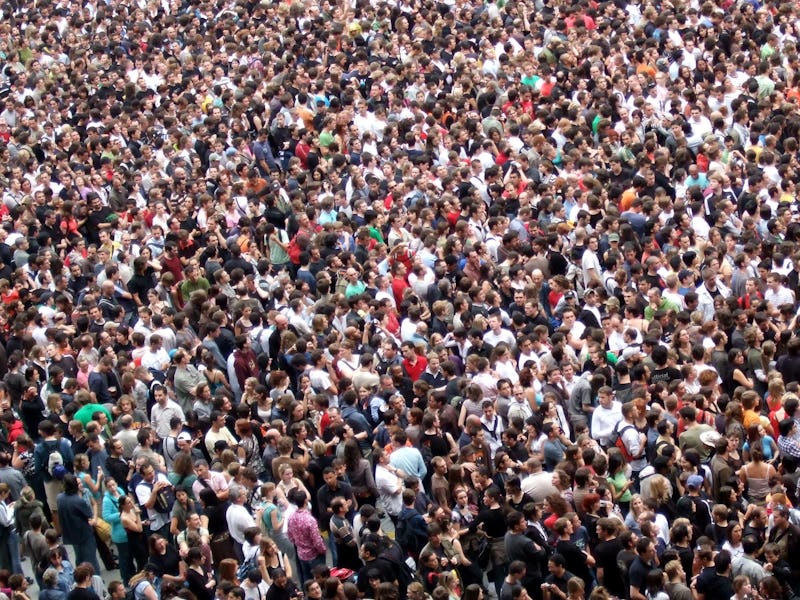How the U.N. Knows the Population of Earth Will Hit 9.7 Billion by 2050
Statistics geeks at the United Nations crunched the numbers, so you don't have to.

Three decades ago, there were fewer than five billion people on the planet. Today there are 7.3 billion. Humans have been having quite a lot of sex.
Still, that sex hasn’t been enough to keep birth rates on the rise — only to grow an aging crowd. We’re living longer and so the population density of Earth is getting very real. If there is not a cataclysm in the intervening years, trends suggest that there will be 9.7 billion people on Earth in 2050. That’s a big number, but it doesn’t phase François Pelletier, the UN’s Chief of Population Estimates and Projections. He just wants to get it right.
“There’s too many people focused on 2100, and the further you go, the less confident we are,” he says. “But by 2050 I would say it’s more reliable.”
Of course it’s impossible to say exactly what will happen over the next 34 years, and so the UN builds some wiggle room into their projection — with 95 percent confidence, the UN expects the world population in 2050 to fall between about 9.3 billion and 10.2 billion. How are they so sure? For one, they’ve got a decent track record. “The projections that were done in the 1960s in the population division were like two percent off from the 2000 population count,” says Pelletier.
It's uncertain what the global population will do by the end of the century.
Where do these projections come from?
It starts with collecting the best data available from every country on Earth on current population, birth rate, death rate, and migration rate. Those numbers get plugged into a statistical model along with historical estimates going back to 1950. Then a computer crunches the numbers, projecting future population scenarios based on the birth and death rate trends in a given country, but also accounting for global trends.
The model runs the equation thousands of times, based on different possible ways that the birth and death rate may shift over time. The result of these runs is a median projection — the most likely scenario — as well as the lower and upper bounds of likely outcomes. There will always be unpredictable events that throw a wrench in the projections for a specific country or region, says Pelletier, but in the big picture these errors have a tendency to cancel each other out.
“In the 1970s, nobody had predicted what would happen in the Gulf countries in terms of migration. The current population boom in the Gulf countries is driven by economic performance and international migration. That was not predicted. These are difficult things to predict.
“Nobody had predicted the HIV/AIDS epidemic. There will be other problems in the future, but at the global level I would think that things balance themselves out.”
I wanted to know how the model accounts for big global impacts, like climate change. But, as Pelletier explains, attempting to plug climate change effects into a population model would be both very difficult and not terribly useful. It’s hard enough to predict how a region’s climate will change, let alone guess at how human births and deaths will respond to that change.
India is expected to become the most populated country in the world by 2022.
It may seem like a pretty big omission, but it’s actually not — in a way, climate change effects on population are fundamentally built into the model.
Here’s how: It’s nearly impossible to say how a warming might affect population in the future, but any real effect that it’s having right now will be hidden within the demographic data, which is then used in making future projections.
Even though the world may seem like it’s becoming a more unpredictable place, Pelletier says our ability to predict future population has actually improved, and that’s because the quality of the data that we start with has become more reliable. “We have more and more information than we used to.”
Though the impacts of a booming global population are not Pelletier’s area of expertise, he says he’s not particularly worried about the ability of the planet to sustain nine or 10 billion people.
But the assumptions that we in the developed world base our fears on are based on stereotypes that are not well reflected in what’s actually happening in poorer countries. In fact, the sooner we can bring people out of poverty and reduce child mortality rates, the sooner the world population will stabilize, and perhaps even begin to decline.
The point here isn’t the number itself but how mathematicians and humanity arrives at it. Population doesn’t become overpopulation by growing, it does so by growing recklessly.